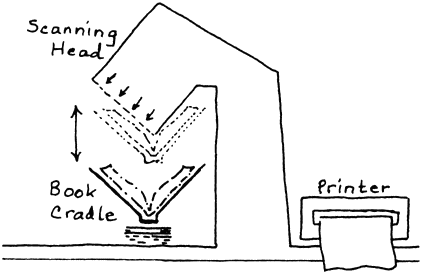

The following notice appeared in Reprographics Quarterly, v.15 #4:
...Now a Swiss company--Wagner & Cie AG--have produced a photocopier configured like a planetary microfilm camera so that books being copied can remain face-up. The Varioprint W 1001 combines the functions of a process camera with that of a xerographic copier. In appearance the unit looks like a large planetary film camera. Originals for copying are placed in a holder beneath a glass flat to hold the page flat. The holder can take single sheets, books--for which a see-saw device to hold the book in a partly open position is provided--or can be supplied with a light box to permit the copying of translucent originals.
...Reproduction ratios are infinitely variable between 50 and 130% but the unit will shortly be obtainable with a reprojection head permitting, additionally, printout from microfilm. The focussing system adjusts automatically to the reduction/enlargement ratios. The machine uses a dry toner xerographic plain paper process. The output speed is about 7 copies per minute--which is slow by conventional copier standards.
Compared to a conventional photocopier the unit is bulky... and expensive at Sw.Fr49,980 (about $24,674) but the facilities it offers for library and map reproduction are unique. According to Wagner, units are in use at [four European libraries]. (Wagner & tie AG, 3414 Oberburg-Burgdorf, Switzerland).
[The British Library's image digitizer, which also works upside down and which was described in the last issue, will be on the market this fall for about 20,000.]

Fall and winter activities at the Center for Book Arts (15 Bleecker St., New York, NY 10012, tel. 212/460-9768) include B classes, 12 weekend workshops, and seven miscellaneous events. Two of the classes are Advanced Bookbinding and Restoration; workshops include Oriental Bindings and three others on making your own equipment; and one of the other events is a dual clinic in printing and binding, for which the blurb starts out, "Does your ink smear? Do your books fall apart? Need a second opinion?"
In preparation for its tenth anniversary next year, the Center plans a major exhibition of its artist members' work at the New York Public Library. Some 200 bookworks of all sorts will be included. Deadline for submission of slides is December 31, 1983.
The Research Libraries Group (RLG) began in May to systematically get microfilm copies of American books published in the last quarter of the last century, most of which are now embrittled and endangered. This is a three-year superproject surpassing the Library of Congress's Brittle Books Program in scale and scope, and funded by NEH and Mellon. (For details, see p. 41 in the July issue.) In August it was announced that LC will join the effort by coordinating its own microfilming with RLG's and will even have its own assignment of types of books to cover. It has also agreed to improve the cataloging of the microfilms it makes, so that the other seven members of the project, and other libraries as well, can tell for sure whether a book has already been filmed and won't do it again by mistake.
For at least ten years, the World Health Organization has been approving as food additives (thickening agents) hydroxy propyl cellulose, hydroxypropyl methyl cellulose, methyl cellulose and sodium carboxymethyl cellulose, in amounts up to 25 mg/kg of body weight. This information is from World Health Organization, Technical Report Series #539, 1974, Toxicological Evaluation of Certain Food Additives....
Among the ingredients listed for Squibb Theragram-M High Potency Vitamin Supplement with Minerals are magnesium carbonate, silica gel, shellac, titanium dioxide, potassium iodide, ethyl cellulose and carnauba wax.
The Canadian Centre for Architecture has initiated the Canadian Architectural Records Survey. The purpose is to collect information about the location, contents, and accessibility of architectural records across the country.
Contact: CARS, 1440 Ouest rue Sainte-Catherine 2ème étage, Montréal, Qué. H3G 1RB, Canada.
In July there were only 28 sponsors in the Senate for the independence bill for the National Archives, S.905; now there are 40. A parallel bill has not yet been introduced in the House, but Jack Brooks will probably introduce one in the next few weeks. There was a Senate hearing on this July 29, at which the Committee was generally supportive. Strong testimony in favor of independence was offered by Barbara Tuchman, former U.S. Archivist James B. Rhoads, Samuel R. Gammon (Executive Director of the American Historical Association) and New York State Archivist Larry Hackman. Gerald Carmen, Administrator of GSA, of which the National Archives is a part, testified against independence, but had little impact because he did not offer a specific plan or legislation.
A short history of the Archives is in Monro MacCloskey's book Our National Attic: The Library of Congress, The Smithsonian Institution, The National Archives (Richard Rosen Press, New York). Originally an independent agency when it opened in the mid-30s, it was brought under the General Services Administration in 1949 as the result of a Hoover Commission recommendation. Its dignity, authority and importance waned gradually thereafter as functions were transferred to other agencies and its isolation from Congressional and Executive department leaders increased. A joint committee of historians and archivists recommended in a special 1966 report that "... .the United States should have an independent National Archives and Records Authority, administered by an Archivist of the United States appointed by the President and assisted by a Board of Regents." [Emphasis added.]
In MacCloskey's words, "The report observed that until changes in the present system are accomplished, the National Archives will continue to demonstrate 'the ill effects of inadequate support of its cultural objectives' through 'the breakdown in systematic controls over the great masses of records. "' And so it has. An independent National Archives, he says, "would soon take its proper place among the great institutions of learning, and its status and scholarly achievements would reflect the nation's appreciation that its national archives constitute one of the richest educational resources in the world."